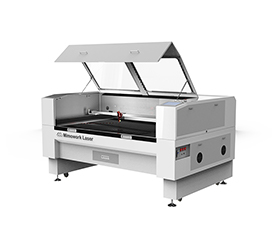Case Sharing
Laser Cutting Wood Without Charring
Using laser cutting for wood offers advantages such as high precision, narrow kerf, fast speed, and smooth cutting surfaces. However, due to the concentrated energy of the laser, the wood tends to melt during the cutting process, resulting in a phenomenon known as charring where the edges of the cut become carbonized. Today, I will discuss how to minimize or even avoid this issue.

Key points:
✔ Ensure complete cutting in a single pass
✔ Use high speed and low power
✔ Employ air blowing with the assistance of an air compressor
How to avoid burning when laser cutting wood?
• Wood Thickness - 5mm maybe a watershed
Firstly, it's important to note that achieving no charring is difficult when cutting thicker wood boards. Based on my tests and observations, cutting materials below 5mm thickness can generally be done with minimal charring. For materials above 5mm, the results may vary. Let's dive into the details of how to minimize charring when laser cutting wood:
• One Pass Cutting will be Better
It is commonly understood that to avoid charring, one should use high speed and low power. While this is partially true, there is a common misconception. Some people believe that faster speed and lower power, along with multiple passes, can reduce charring. However, this approach can actually lead to increased charring effects compared to a single pass at optimal settings.

To achieve optimal results and minimize charring, it is important to ensure that the wood is cut through in a single pass while maintaining low power and high speed. In this case, a faster speed and lower power are preferred as long as the wood can be fully cut through. However, if multiple passes are required to cut through the material, it can actually lead to increased charring. This is because the areas that have already been cut through will be subjected to secondary burning, resulting in more pronounced charring with each subsequent pass.
During the second pass, the parts that were already cut through are subjected to burning again, while the areas that were not fully cut through in the first pass may appear less charred. Therefore, it is crucial to ensure that the cutting is achieved in a single pass and avoid secondary damage.
• Balance between Cutting Speed and Power
It is important to note that there is a trade-off between speed and power. Faster speeds make it more difficult to cut through, while lower power may also hinder the cutting process. It is necessary to prioritize between these two factors. Based on my experience, faster speed is more important than lower power. Using a higher power, try to find the fastest speed that still allows for complete cutting. However, determining the optimal values may require testing.
Case Sharing – how to set parameters when laser cutting wood

3mm Plywood
For example, when cutting 3mm plywood with the CO2 laser cutter with an 80W laser tube, I achieved good results using 55% power and a speed of 45mm/s.
It can be observed that at these parameters, there is minimal to no charring.
2mm Plywood
For cutting 2mm plywood, I used 40% power and a speed of 45mm/s.

5mm Plywood
For cutting 5mm plywood, I used 65% power and a speed of 20mm/s.
The edges started to darken, but the situation was still acceptable, and there was no significant residue when touching it.
We also tested the machine's maximum cutting thickness, which was an 18mm solid wood. I used the maximum power setting, but the cutting speed was significantly slower.
Video Display | How to Laser Cut 11mm Plywood
Tips of removing wood dark
The edges have become quite dark, and carbonization is severe. How can we deal with this situation? One possible solution is to use a sandblasting machine to treat the affected areas.
• Strong Air Blowing (air compressor is better)
In addition to power and speed, there is another important factor that affects the issue of darkening during wood cutting, which is the use of air blowing. It is crucial to have strong air blowing during wood cutting, preferably with a high-power air compressor. The darkening or yellowing of the edges can be caused by the gases generated during cutting, and the air blowing helps facilitate the cutting process and prevent ignition.
These are the key points to avoid darkening when laser cutting wood. The test data provided are not absolute values but serve as reference, leaving some margin for variation. It is important to consider other factors in practical applications, such as uneven platform surfaces, uneven wood boards affecting focal length, and the non-uniformity of plywood materials. Avoid using extreme values for cutting, as it may just fall short of achieving complete cuts.
If you find that the material consistently darkens regardless of cutting parameters, it may be an issue with the material itself. The adhesive content in plywood can also have an impact. It is important to find materials that are more suitable for laser cutting.
Choose Suitable Wood Laser Cutter
Pick one laser machine that suits you !
Any questions about the operation of how to laser cut wood without charring?
Post time: May-22-2023




